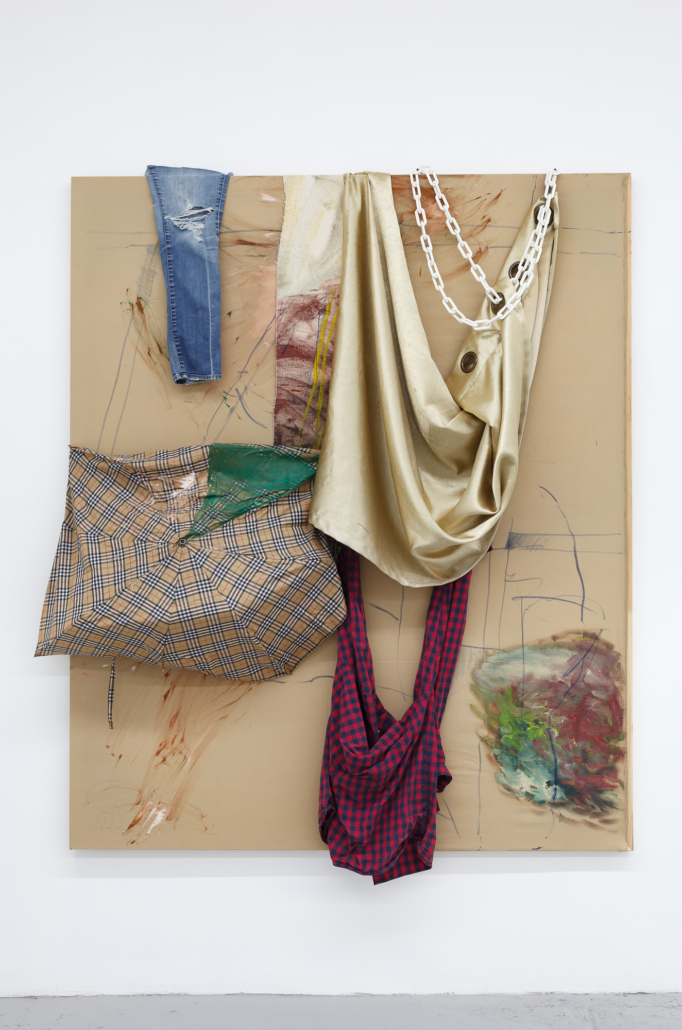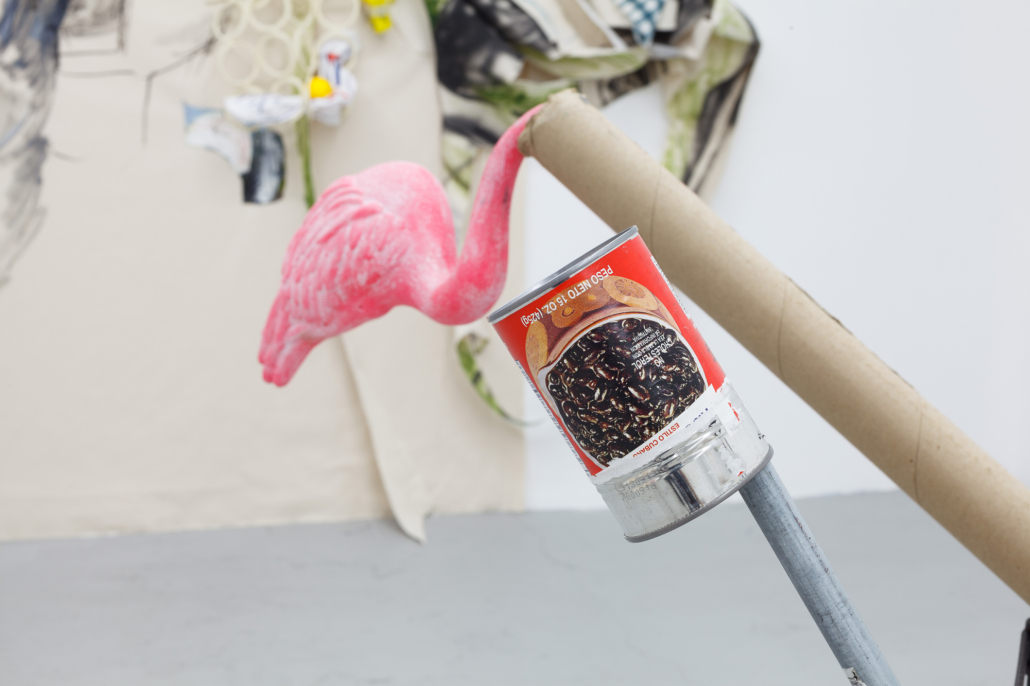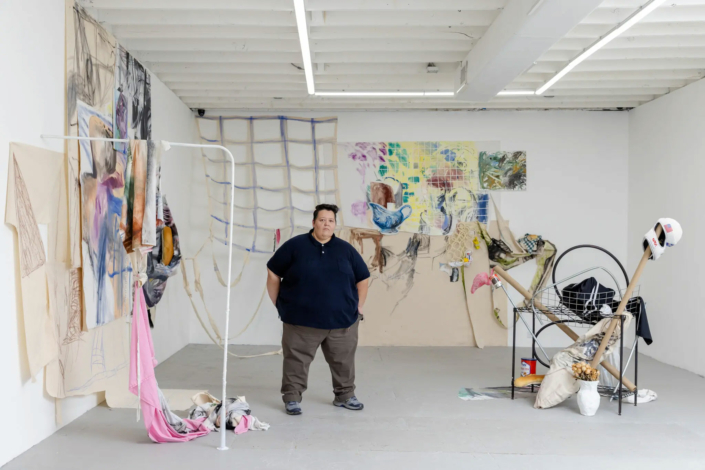Memento Mori, Reimagined
Upon entering Between Memory and Desire, I noticed the fruit. I slowly made my way to Fruit and Labor (2022), also taking in the way in which the light seemed to glisten off the gold curtain at the center of the piece. I joked that the artificial mango was calling my name, given that I am extremely allergic and wince at the sight of one. In the midst of all those details, I was again inspired by the way Clara Varas is able to draw a viewer in, simply by enticing your senses. Varas pulls you closer without much manipulation—you simply want to understand what you are seeing. Fruit and Labor evokes the presence of the artist’s hand with the glove at the very top, appearing to open the curtain and inviting you to look behind it. The glove becomes an archetypal symbol of the Surrealist movement after Breton publishes the First Manifesto of Surrealism in 1924. Artists such as Valentine Hugo and Man Ray also include images of the glove in their poem- and dream-objects. A gloved hand can also conjure up images of André Breton’s seminal text Nadja, originally published in 1928. If you look just a few years before Surrealism exploded onto the scene, you would also find one of Breton’s greatest influences, Giorgio de Chirico including the glove in one of his most iconic paintings. Giorgio de Chirico’s The Song of Love (1914), prominently features a large red rubber glove on the right side of the composition. If one is patient enough, the art historical references in Varas’s work come out to play.
The title of Fruit and Labor alludes to both the labor it takes to harvest fruit, and the labor it takes to produce a work of art. There is also no doubt that the title references the art historical genre of still-life painting—considered the lowliest of genres at the height of the Baroque period and underappreciated for decades. The title’s many interpretations can lead the viewer in any direction they so choose, making the work infinitely accessible. Given that Varas’s work often ties the smallest of details to influential and momentous art historical moments, my chosen path is to investigate and reimagine memento mori through the works included in Between Memory and Desire. Memento mori is an artistic or symbolic trope acting as a reminder of the inevitability of death. More specifically, a vanitas is a still-life artwork that includes various symbolic objects designed to remind the viewer of their mortality. Clara Varas’s works are not simply paintings or installations but a combination and extension of both. They are also sculptural, embedding found objects into its composition and providing even more entry points for the viewer to examine. Take Nos Comimos El Miedo (We Ate Our Fear) (2022) as an example. The title is written onto the raw canvas on the left side of the work—forcing the viewer to search for it, forcing us to move about in hopes of discovering more text. Though there are pieces of the work hanging on the wall as a painting would, there is also a sculptural element in the wire basket placed just a few feet in front of the wall elements. There is a soft replica of a NASA space helmet that creates the illusion of a figure—not entirely unlike the gloved hand in Fruit and Labor. The piece also spans two walls—a loose grid and painted raw canvas connects the two and makes the viewer question whether or not the work is instead an installation. Can’t Nos Comimos El Miedo (We Ate Our Fear) be an installation, a painting, and a sculpture? Varas would probably argue that they indeed could be. I would have to agree.
One of the most touching pieces in the exhibition is Portrait of My Wife (2022). The raw canvas becomes a sort of backdrop for Varas’s wife’s belongings, which seem to come out and almost whisper their secrets to you. There is something incredibly intimate about clothing, especially clothing as portrait—they represent you although they cover every inch of you. Clothing sits on your body, it clings to every curve, leaving marks and details that could only be linked back to the sitter. Varas’s portrayal of her wife also evokes movement and rhythm—the shirt is hanging by its cuffs but allows for us to envision her wife throwing her hands up in the air. The jeans are hanging off the top of the raw canvas, as though they’ve been left on the chair in the bedroom, waiting to be used again for tomorrow’s errand run. The curtain alludes to a sense of privacy, perhaps an intimacy between them that is to be kept only between the two of them. The umbrella reminds us not only of Varas’s wife’s encounters with Miami’s unpredictable weather, but the storms that brew within each of us, and the way those storms can be resolved and faced within a marriage. In many ways, the work is not merely a portrait of Varas’s wife, but a portrait of their relationship as Varas sees and feels it.
The combination of found objects and references to still-life painting is what can give Varas’s work a solemn interpretation but I would beg to differ that her work isn’t merely reminding us that death is on the horizon, but that we are living life now, making memories as I write this—as you read this. Varas’s work is a record of a moment in time reminding us all that this moment will simply not be ours again, it lives on only in the ways in which we’ve chosen to mark them in our memory. Varas’s practice has always referred to cultural identity and migration. The details and elements of still-life that she chooses for her works are markers of her own background—a Cuban born artist now living in Miami. The look back at her own heritage isn’t always present in Varas’s work but sometimes, as we see in Nos Comimos El Miedo (We Ate Our Fear), the Cuban bread points us in the right direction. The Cuban bread hidden away in Nos Comimos El Miedo (We Ate Our Fear) will decompose and lose its shape. The mango in Fruit and Labor will rot. The works will remain, the message remains the same, the fruit can be replaced.
Maritza M. Lacayo
Maritza Lacayo is Assistant Curator at Pérez Art Museum Miami (PAMM). At PAMM she has curated numerous exhibition projects, including: The Artist as Poet: Selections from PAMM’s Collection, Marco Brambilla: Heaven’s Gate, George Segal: Abraham’s Farewell to Ishmael, Polyphonic: Celebrating PAMM’s Fund for African American Art, Jedd Novatt: Monotypes and More, among others. Lacayo has various exhibition projects forthcoming, including Jason Seife: Coming to Fruition, and monographic exhibitions featuring Calida Garcia Rawles and José Parlá. Lacayo has organized traveling exhibitions on behalf of PAMM, including Marisol and Warhol Take New York, Leandro Erlich: Liminal, and Joan Didion: What She Means (forthcoming)—all co-organized with PAMM’s Director, Franklin Sirmans. Lacayo regularly works with the YoungArts Foundation as a Master Teacher, also curating both the Regional and National exhibitions in 2019 and 2020, respectively. Lacayo frequently contributes writing to arts platforms and exhibition catalogues including monographs for artists Tomokazu Matsuyama, Richard Dupont, Carlos Estévez, and Vaughn Spann. She has managed the production of several publications and exhibition catalogues for PAMM including Dara Friedman: Perfect Stranger, On the Horizon: Contemporary Cuban Art from the Jorge M. Pérez Collection, Ebony G. Patterson…while the dew is still on the roses…, The Other Side of Now: Foresight in Contemporary Caribbean Art, and Beatriz González: A Retrospective (Named one of The New York Times’s Best Art Books of 2019). She holds a Bachelor of Arts in Art History from the American University of Paris and a Master of Letters in Modern and Contemporary Art and Art World Practice from the University of Glasgow, Scotland.












